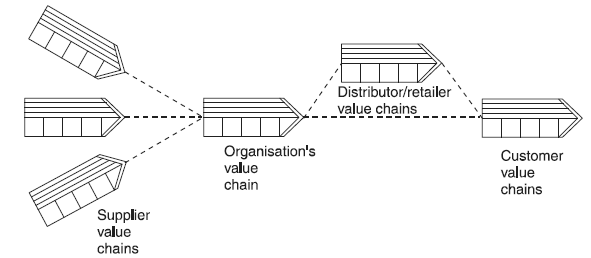When a business wants to expand its operation or market shares, it will look at how it would decide to invest either by using its existing capability or value network or look at the opportunities outside its capability and value networks. Vertical integration is one of the options for its diversification in order to expand its operation.
In this article, we cover vertical integration, how it works, types as well as its advantages and disadvantages.
So let’s get started!
What is Vertical Integration?
Vertical integration is one type of related diversification that an organization looks into in order to expand its operation by using its existing capability and value networks. It occurs when a company wants to expand its operation by using its existing value networks in order to become its own suppliers, distributors, or customers.
In order to easily understand, let’s look at what the value networks are.
The value network or value system refers to the set of interconnected relationships of an organization among the value chain both customer and supplier’s value chain. Let’s look at the diagram below:

As you can see from the diagram above, the value network consists of the upstream network which is suppliers, and a downstream which is with distributors/retailers or customers.
There are two types of vertical integration. These are backward vertical integration and forward vertical integration.
Backward integration is also known as upstream integration. This is done by acquiring or taking over a supplier. Basically, a company pursues backward integration in order to secure reliable and stable inputs or resources in order to supply the manufacturing or production process.
The backward integration strategy is so important when the current suppliers are not reliable and the costs of buying from the outside supply are high as they require a very high margin.
Likewise, forward vertical integration is also known as downstream integration. This is done by expanding by taking over its distributors
The forward integration is so important when there are not many reliable distributors and they charge very high-profit margins.
How Vertical Integration Work?
As mentioned above, vertical integration works by expanding its operation through its existing capability and value networks.
Backward Vertical Integration
For backward integration, a company seeks to expand its business by acquiring or taking over the suppliers. This means that they focus on the upstream value network in order to achieve a more efficient and reliable suppliers’ value chain.
For example, wine manufacture acquires a bottle supplier upstream of the value chain. This is to ensure that the supply of bottles is efficient and reliable at a reasonable price.
Forward Vertical Integration
In contract, in the forward integration, a company seeks to expand its business by acquiring or taking over the distributors. This means that they focus on the downstream value network in order to achieve a more efficient and reliable customer’s value chain.
For example, a manufacturer of shoes owns its distribution channel shop to sell shoes to its customer. This is a forward integration by engaging with its downstream of customers’ value chain. This is because the company wants to achieve a larger market share and higher economies of scale.
Advantages of Vertical Integration
There are a number of advantages as below:
- Secure the efficient and reliable supply of components for materials at a lower price
- Maintain strong relationships with its final consumers of products.
- Allow a more effective pursuit of differentiation strategy
- Maintain a share of profit at all stages of value systems
- Create a barrier of entry by maintaining and controlling the supplies/distribution or retail outlets.
- Maintain economies of operations and internal control
Disadvantages of Vertical Integration
Although it provides a lot of advantages, there are also a number of disadvantages as below:
- It may create an overconcentration; thus would create inflexibility in looking at outside suppliers who have more economies of scale.
- It may, sometimes, require a big capital investment.
- Reduce the flexibility of choosing suppliers that can provide cheaper costs.
Conclusion
Vertical integration is a good strategy for expansion where the company could focus on its existing capability and value network. We can adopt this diversification strategy through both backward and forward integration.


